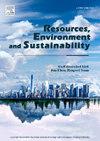微生物发酵在饲料粮、口粮、水稻和玉米共青贮中的应用,以提高饲料质量和增强水稻生产系统的可持续性
IF 12.4
Q1 ENVIRONMENTAL SCIENCES
引用次数: 0
摘要
为提高饲料稻品质,促进南方水稻和畜牧业的可持续发展,研究了饲料稻与玉米或高粱-苏丹草杂交种共青贮的微生物发酵动态。结果表明,与高粱-苏丹草杂交品种相比,与玉米共青贮显著改善了发酵品质,降低了纤维含量,提高了乳酸产量。以75:25的fgr /玉米比例为最佳,中性洗涤纤维和酸性洗涤纤维值最低,乳酸浓度最高(39.37 g/kg DM)。共青贮促进了有益乳酸菌(LAB)的生长,尤其是乳酸杆菌科(Lactobacillaceae)和孢乳杆菌科(Sporolactobacillaceae),从而提高了发酵效率。此外,接种植物乳杆菌通过促进乳酸菌生长和抑制不良肠杆菌种类的生长来提高青贮的稳定性。本研究为优化秸秆作为牲畜饲料的利用,减少对进口饲料的依赖,支持中国农业可持续发展提供了可持续策略。本文章由计算机程序翻译,如有差异,请以英文原文为准。

Microbial fermentation in co-ensiling forage-grain ratoon rice and maize to improve feed quality and enhance the sustainability of rice-based production systems
To enhance the quality of forage-grain ratoon rice (FGR) and promote the sustainable development of both rice and livestock industries in southern China, this study investigates the microbial fermentation dynamics of co-ensiling FGR with maize or sorghum-sudangrass hybrid. Results demonstrate that co-ensiling with maize significantly improved fermentation quality, reducing fiber content and enhancing lactic acid production, compared with sorghum-sudangrass hybrid. The optimal FGR-to-maize ratio of 75:25 yielded the lowest neutral detergent fiber and acid detergent fiber values and the highest lactic acid concentration (39.37 g/kg DM). Co-ensiling promoted the growth of beneficial lactic acid bacteria (LAB), particularly Lactobacillaceae and Sporolactobacillaceae, thus enhancing fermentation efficiency. Additionally, inoculation with Lactobacillus plantarum improved silage stability by promoting LAB growth and inhibiting the growth of undesirable Enterobacter species. This study offers a sustainable strategy to optimize rice straw utilization for livestock feed, reduce dependence on imported forages, and support agricultural sustainability in China.
求助全文
通过发布文献求助,成功后即可免费获取论文全文。
去求助
来源期刊

Resources Environment and Sustainability
Environmental Science-Environmental Science (miscellaneous)
CiteScore
15.10
自引率
0.00%
发文量
41
审稿时长
33 days
 求助内容:
求助内容: 应助结果提醒方式:
应助结果提醒方式:


